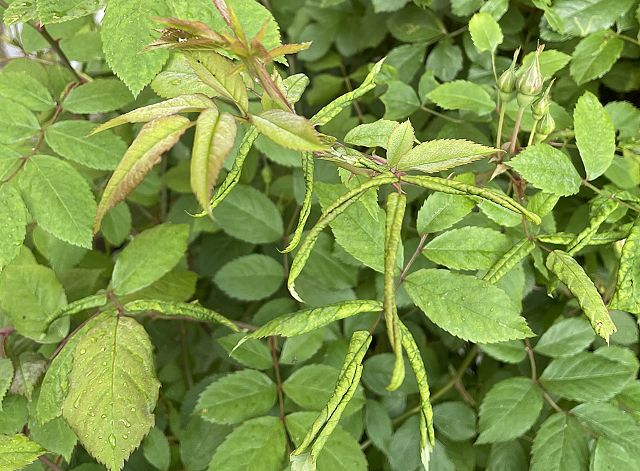And this is how you recognize the harmful fungi:
 The powdery mildew forms a white coating on the upper side, especially of young leaves and buds. Pruning is appropriate.
The powdery mildew forms a white coating on the upper side, especially of young leaves and buds. Pruning is appropriate.
In downy mildew, purple-brown leaf spots, which may be defined by leaf veins, appear on the upper side of leaves, as well as a white-gray coating under leaves on the flowers.
The common star rust forms brown-black, round spots on the leaf surface, with the edges fringed in a star shape. The leaf turns yellow and falls off.
Rose rust can be recognized by small orange spots on the lower leaf surface.
Gray mold occurs preferably after prolonged rain and covers flowers, buds and young shoots with a gray fungal lawn. Unfortunately, the only remedy is cutting and removal.
Bark burn attacks overly soft, immature shoots and forms elongated, dark spots on the bark. Countermeasures include fertilizing as needed and spraying with green copper in winter.
Animal pests

The green rose aphid sucks mainly on young shoots and buds. Spraying with a powerful stream of water is often enough as a countermeasure. Natural antagonists such as titmice and ladybugs will soon assist you. If necessary, you can also spray a green soap solution.
The rose shoot borer (there is an upward and a downward climbing one) occurs on garden roses from June to September. Shoots suddenly wilt and dry up due to the conduit pathways being eaten away by larvae. As a countermeasure, the wilting, infested shoots should be cut back to healthy wood (white inside) and disposed in household trash.
The rose beetle (about 1-2 cm in size) and the rapeseed beetle (about 2-3 mm in size), which destroy the inside of the buds, can be easily collected by hand in the morning.
The young rose leaves that are curled downwards are the damage of the leafroller wasps. They lay their eggs on the bottom of the leaves in May. Unfortunately, the only thing that helps here is to cut off the curled leaves. Dispose of them in the household waste so that the larvae cannot hatch.
Feeding damage by the white-greenish larvae of the leafroller wasp, which occur from May to July, cause leaves to turn yellow and curl. The larvae, which are just under 1 cm in size, are found in these rolls of leaves. To best remedy is to collect the rolled leaves from the ground or cut them off and destroy them.
An infestation of rose cicadas (similar to the aphid, white-green, hopping or flying) can be recognized by the white speckles on the upper side of the leaf. If necessary, chemical pesticides will help.
The spider mites (syn. red spider) damage by sucking activities and can be recognized by the fine webs around the flowers. It helps to moisten the environment, remove infested shoots and dispose of them in household waste.

Voles like to eat the bark of rose roots. You can use box traps, please handle with gloves to avoid odor. Apple, celery or peeled carrots serve as bait. Support natural predators such as birds of prey by providing perches or weasels by offering wood or rock piles.
Deer also like to eat young rose buds and shoots. They can be kept away by strands of human hair, buttermilk or, best of all, scaring products available at specialty stores.
